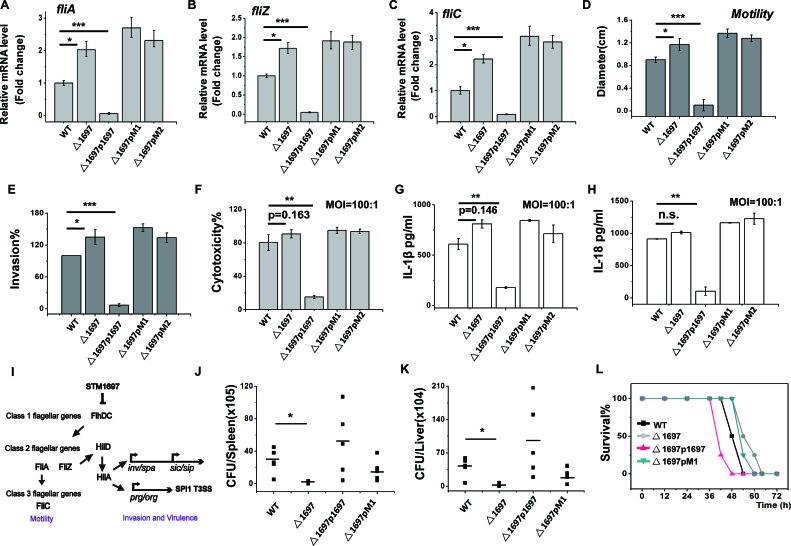Figure 7.
The suppression of STM1697 of cell motility and virulence phenotypes is mediated by its interaction with FlhD. (A–C) The expression levels of flagellar gene fliA, fliZ and fliC in the wild-type strain, the STM1697 knockout strain and the STM1697 or mutant over-expressed strains were separately tested by qRT-PCR. GADPH was used as an internal reference. (D) The motility of the wild-type strain, the STM1697 knockout strain and STM1697 or mutant over-expressed strains were measured on a 0.3% soft agar plate. (E) Invasion capability of those strains for HT-29 cells. (F) Bone marrow-derived macrophages (BMDM) from BALB/c mice were infected by the strains. Cytotoxicity was determined by LDH release 4 h post-infection. (G and H) IL-1βor IL-18 secretion of BMDM infected with MOI 100:1 were determined by ELISA after 4 h post-infection. (I) Model illustrating the mechanism of STM1697-mediated invasion and virulence regulation. (J and K) BALB/c mice were infected with equal numbers of those strains by intraperitoneal injection. CFU in the spleen and liver were determined after 6 h. (L) BALB/c mice were infected with equal numbers of the wild-type strain, the STM1697 knockout strain, and over-expressed STM1697 or mutant strains by intraperitoneal injection. Survival was monitored. Bars represent data from three independent experiments. Statistical significance is indicated by *P < 0.05, **P < 0.01 and ***P < 0.001 as compared with wild-type Salmonella typhimurium ATCC14028 using a t-test. WT: S. typhimurium ATCC14028 VC; Δ1697: Δstm1697 VC; Δ1697p1697: Δstm1697p1697; Δ1697pM1: Δstm1697pM1; Δ1697pM2: Δstm1697pM2. VC = pBAD24, p1697 = STM1697 cloned into pBAD24, pM1 = STM1697 F160A, L173A cloned into pBAD24 and pM2 = STM1697 L172A, L173A, H176A cloned into pBAD24. In all experiments, protein expression was monitored by qPCR and sodium dodecyl sulphate-polyacrylamide gel electrophoresis (see Supplementary Figure S3).

